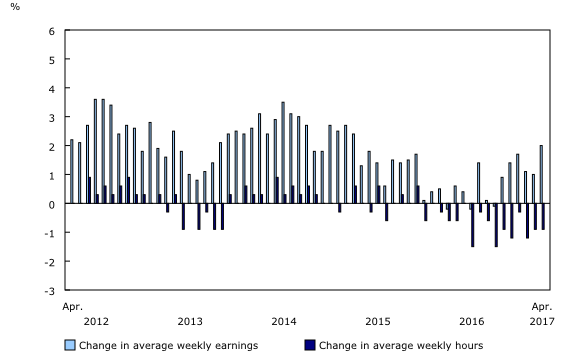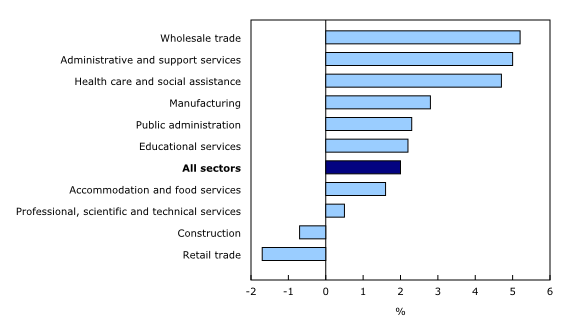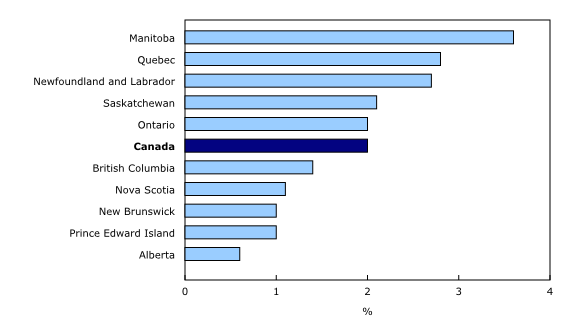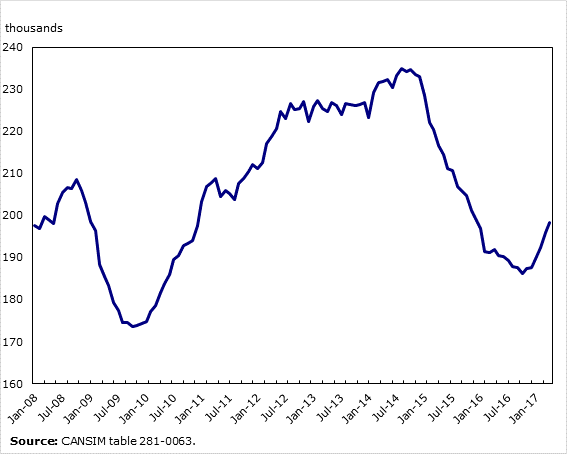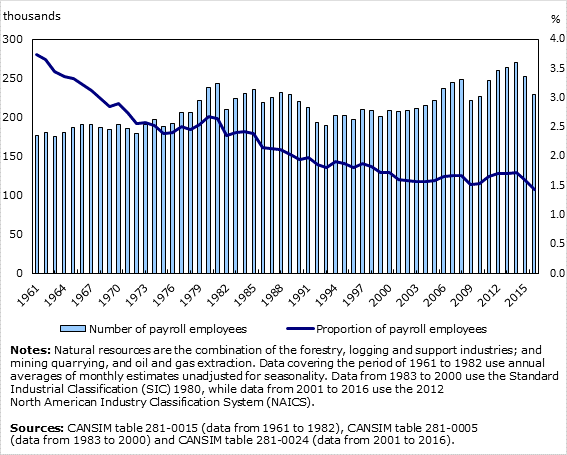Payroll employment, earnings and hours, April 2017
Archived Content
Information identified as archived is provided for reference, research or recordkeeping purposes. It is not subject to the Government of Canada Web Standards and has not been altered or updated since it was archived. Please "contact us" to request a format other than those available.
Released: 2017-06-29
$971.13
April 2017
2.0% 
(12-month change)
$1,032.39
April 2017
2.7% 
(12-month change)
$817.00
April 2017
1.0% 
(12-month change)
$862.80
April 2017
1.1% 
(12-month change)
$880.67
April 2017
1.0% 
(12-month change)
$898.74
April 2017
2.8% 
(12-month change)
$987.88
April 2017
2.0% 
(12-month change)
$919.70
April 2017
3.6% 
(12-month change)
$1,004.61
April 2017
2.1% 
(12-month change)
$1,125.69
April 2017
0.6% 
(12-month change)
$934.23
April 2017
1.4% 
(12-month change)
$1,080.45
April 2017
6.0% 
(12-month change)
$1,387.19
April 2017
-5.0% 
(12-month change)
$1,333.04
April 2017
4.2% 
(12-month change)
Average weekly earnings of non-farm payroll employees were $971 in April, little changed from March. Compared with April 2016, earnings were up 2.0%, with most of the increase occurring in the last two months of 2016.
In general, changes in weekly earnings reflect a number of factors, including wage growth; changes in the composition of employment by industry, occupation and level of job experience; and average hours worked per week.
Non-farm payroll employees worked an average of 32.6 hours per week in April, unchanged from the previous month and down from 32.9 hours in April 2016.
Average weekly earnings by sector
Compared with April 2016, average weekly earnings of non-farm payroll employees grew in 6 of the 10 largest industrial sectors. Earnings rose most rapidly in wholesale trade, followed by administrative and support services, health care and social assistance, manufacturing, public administration, and educational services. Average earnings declined in retail trade, while there was little change in the remaining large sectors.
Average weekly earnings in wholesale trade were up 5.2% to $1,219, with the largest increase in wholesalers of machinery, equipment and supplies. Earnings in the wholesale trade sector rose fastest in Ontario, Prince Edward Island and Newfoundland and Labrador. Earnings in wholesale trade have been on an upward trend since December 2016.
In administrative and support services, average weekly earnings rose 5.0% to $824. Earnings growth was observed in several provinces, with the largest increases in Quebec and Newfoundland and Labrador.
Average weekly earnings in health care and social assistance increased 4.7% to $895, driven by gains in the nursing and residential care facilities subsector and in the hospitals subsector. Growth in this sector was widespread across the provinces, led by Saskatchewan.
In manufacturing, average weekly earnings grew 2.8% to $1,112, notably in the primary metal, machinery, and wood product manufacturing subsectors. Ontario and Quebec contributed the most to earnings growth in this sector.
Average weekly earnings in public administration rose 2.3% to $1,240, boosted by gains in local, municipal and regional public administration. The largest increases in public administration earnings were in the western provinces of Alberta, Saskatchewan and British Columbia.
In educational services, average weekly earnings increased 2.2% to $1,043, driven by increases in elementary and secondary schools, and community colleges and CEGEPs. Alberta and Newfoundland and Labrador had the largest rise in average earnings among the provinces.
In contrast, average weekly earnings in retail trade were down 1.7% to $560, driven by decreases in general merchandise stores. Declines were observed in most provinces and were largest in Prince Edward Island.
Average weekly earnings by province
In the 12 months to April, average weekly earnings of non-farm payroll employees were up in seven provinces, led by Manitoba. Earnings were little changed in Prince Edward Island, New Brunswick and Alberta.
Average weekly earnings in Manitoba rose 3.6% to $920, driven by finance and insurance, health care and social assistance, and construction. Earnings in the province have trended upwards since October 2016.
Average weekly earnings in Quebec increased 2.8% to $899. Earnings growth was spread across most sectors, with health care and social assistance, manufacturing, administrative and support services, and wholesale trade contributing the most to the gains. Earnings in the province have been on an upward trend since the summer of 2016.
In Newfoundland and Labrador, average weekly earnings grew 2.7% to $1,032. Earnings in the province were boosted by notable gains in health care and social assistance, construction and educational services.
In Saskatchewan, average weekly earnings were up 2.1% to $1,005, primarily driven by health care and social assistance, and educational services.
Average weekly earnings in Ontario grew 2.0% to $988. Earnings growth was most notable in wholesale trade, and health care and social assistance.
In British Columbia, average weekly earnings rose 1.4% to $934, with finance and insurance, and educational services contributing most to the rise.
Average weekly earnings in Nova Scotia increased 1.1% to $863. This growth was mostly attributable to finance and insurance, and transportation and warehousing.
Non-farm payroll employment by sector
The total number of non-farm payroll employees was little changed in April. However, the number of payroll jobs rose in administrative and support services, transportation and warehousing, and mining, quarrying, and oil and gas extraction. At the same time, the number of payroll employees declined in retail trade and in information and cultural industries.
In the 12 months to April, the number of non-farm payroll employees rose by 232,600 (+1.5%). Increases were observed in most of the largest industrial sectors, led by health care and social assistance (+36,000 or +1.9%), accommodation and food services (+30,600 or +2.4%), and professional, scientific and technical services (+24,600 or +2.9%). At the same time, there were fewer payroll jobs in wholesale trade (-2,800 or -0.4%).
Following a downward trend that began at the end of 2014, the number of jobs increased in mining, quarrying, and oil and gas extraction (+12,300 or +6.6%) since October 2016, primarily the result of gains in Alberta.
Recent labour market developments
In the 12 months to April, the pace of employment growth has been similar in both of Statistics Canada's monthly surveys with data on employment: the Survey of Employment, Payrolls and Hours (SEPH) and the Labour Force Survey (LFS).
During this period, both surveys showed employment gains in the most populous provinces of Ontario, Quebec and British Columbia, as well as in Manitoba. For example, in Manitoba, the number of payroll employees in the SEPH grew 1.0%, while average weekly earnings rose 3.6%. At the same time, the LFS showed similar employment growth in the province, and the unemployment rate declined 0.8 percentage points to 5.4%.

In celebration of the country's 150th birthday, Statistics Canada is presenting snapshots from our rich statistical history.
The evolution of employment in natural resources
Natural resources consist of the forestry, logging and support, and mining, quarrying, and oil and gas extraction sectors. Natural resources have always been important to Canada's economy.
From 1896 to 1899, the Klondike Gold Rush played a major role in the development of Canada's natural resources, spurring interest in metal and mineral exploitation in British Columbia and northern Ontario. With a vast amount of forests for lumber production, as well as rivers to generate hydro-electricity, Canada emerged as a resource-based economy in the early decades of the 20th century.
Increased demand for Canadian products during the First World War resulted in wood and metal exports reaching record highs. However, employment in natural resources was negatively affected by the Great Depression of the late 1920s and early 1930s, resulting in lower demand for resource-dependent exports.
Following the Second World War, employment in natural resources regained strength as new sources of capital, both foreign and domestic, enabled the extraction of additional resources such as iron, uranium, oil, and natural gas. In 1961 and again in 1962, paid workers in natural resources accounted for 3.7% of total employment.
Despite the high unemployment and inflation (known as 'stagflation') that came with the oil shock from 1973 to 1975, employment in natural resources rose, from under 190,000 in 1975 to over 240,000 in 1981. Following the recession of the early 1980s, employment rose in the mid-1980s and shifted more toward the West. Since 1985, Alberta and British Columbia have employed about half of all the country's employees in natural resources.
With increased demand for oil and gas since the mid-1990s, following the recession of the early 1990s, employment in natural resources trended upwards until the 2008-2009 recession. Despite a substantial decline in employment during this recession, employment in natural resources subsequently rose by nearly 50,000 and peaked at 270,000 in 2014. For its part, Alberta has accounted for more than 40% of national employment in natural resources since 2002 and reached nearly 51% in 2014.
As the market adjusted to lower oil prices in 2015, and in the aftermath of the Fort McMurray wildfires, employment in natural resources fell below 230,000 in 2016, with a proportion of less than 2% of all paid employees in Canada. Since the start of 2017, employment in natural resources was up by about 10,000 to 240,000.
For more information, see "The Impact of Lower Earnings in Alberta on Earnings Growth at the National Level." Economic Insights (11-626-X) and "Wildfires in northern Alberta: Impact on hours worked, May and June, 2016" in the Daily.
Source: "One hundred years of labour force." Canadian Social Trends (11-008-X).
Note to readers
The Survey of Employment, Payrolls and Hours (SEPH) is produced by a combination of a census of approximately one million payroll deductions provided by the Canada Revenue Agency, and the Business Payrolls Survey, which collects data from a sample of 15,000 establishments. Federal, provincial and territorial public administration data are collected from various administrative records provided by these levels of government. The key objective of the SEPH is to provide a monthly portrait of the level of earnings and the number of jobs and hours worked by detailed industry at the national, provincial and territorial levels.
Estimates of average weekly earnings and hours worked are based on a sample and are therefore subject to sampling variability. This analysis focuses on differences between estimates that are statistically significant at the 68% confidence level. Payroll employment estimates are based on a census of administrative data and are not subject to sampling variability.
Statistics Canada also produces employment estimates from its Labour Force Survey (LFS). The LFS is a monthly household survey, the main objective of which is to divide the working-age population into three mutually exclusive groups: the employed (including the self-employed), the unemployed, and those not in the labour force. This survey is the official source for the unemployment rate and collects data on the socio-demographic characteristics of all those in the labour market.
As a result of conceptual and methodological differences, estimates of changes from SEPH and LFS do differ from time to time. However, the trends in the data are quite similar. To better understand the conceptual differences between employment measures from the LFS and SEPH, refer to section 8 of the Guide to the Survey of Employment, Payrolls and Hours (72-203-G).
Unless otherwise stated, this release presents seasonally adjusted data, which facilitate comparisons by removing the effects of seasonal variations. For more information on seasonal adjustment, see Seasonally adjusted data – Frequently asked questions.
Non-farm payroll employment data are for all hourly and salaried employees, as well as for the "other employees" category, which includes piece-rate and commission-only employees.
Unless otherwise specified, average weekly hours data are for hourly and salaried employees only and exclude businesses that could not be classified to a North American Industry Classification System (NAICS) code.
All earnings data include overtime pay and exclude businesses that could not be classified to a NAICS code. Earnings data are based on gross taxable payroll before source deductions. Average weekly earnings are derived by dividing total weekly earnings by the number of employees.
With each release, data for the current reference month are subject to revision. Data have been revised for the previous month. Users are encouraged to request and use the most up-to-date data for each month.
Real-time CANSIM tables
Real-time CANSIM tables 281-8023, 281-8026, 281-8047 and 281-8063 will be updated on July 10. For more information, consult the document Real-time CANSIM tables.
Next release
Data on payroll employment, earnings and hours for May will be released on July 27.
Products
A summary table is also available.
Job Vacancy Statistics (5202) from the Survey of Employment, Payrolls and Hours for March are now available in CANSIM.
More information about the concepts and use of the Survey of Employment, Payrolls and Hours and Job Vacancy Statistics is available in the Guide to the Survey of Employment, Payrolls and Hours (72-203-G).
Contact information
For more information, contact us (toll-free 1-800-263-1136; 514-283-8300; STATCAN.infostats-infostats.STATCAN@canada.ca).
To enquire about the concepts, methods or data quality of this release, contact Dylan Saunders (613-762-6972; dylan.saunders@canada.ca) or Client Services (toll-free: 1-866-873-8788; statcan.labour-travail.statcan@canada.ca), Labour Statistics Division.
- Date modified:


